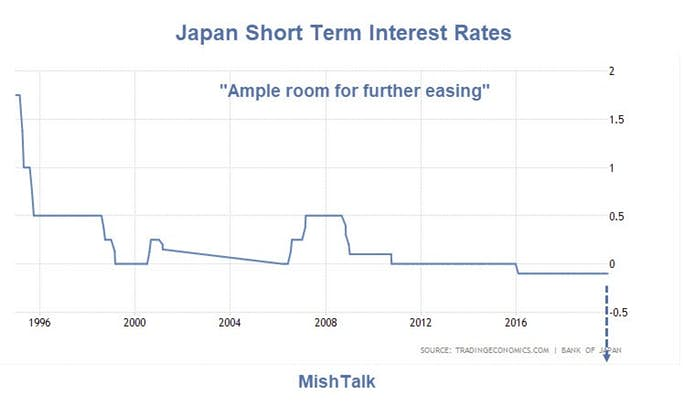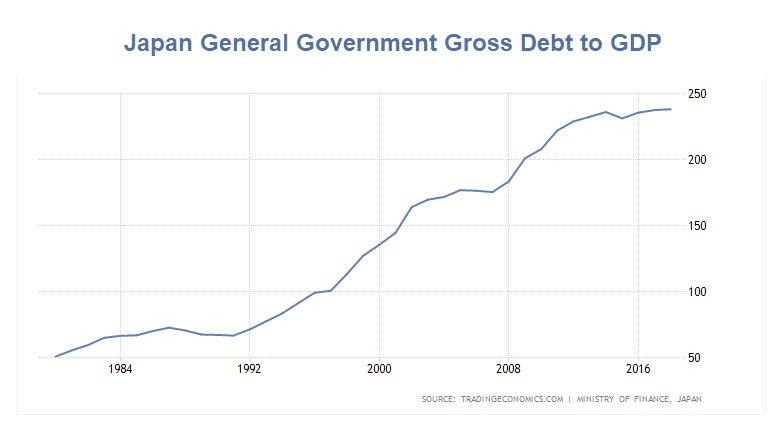The Bank of Japan is looking at further easing as retail sales plunge.
Retail Sales Plunge to 4.5 Year Low
On October 1, Japan increased its sales tax to 10 percent from 8 percent. In response, Japan's Retail Sales Plunge to a Multi-Year Low.
Japan's retail sales tumbled at their fastest pace in more than four and a half years in October as a sales tax hike prompted consumers to cut spending, raising a red flag over the strength of domestic demand.
Retail sales fell 7.1 percent in October from a year earlier, pulled down by weak demand for big-ticket items such as cars and household appliances as well as clothing, trade ministry data showed on Thursday. The data showed department store sales were hit particularly hard.
The drop marked the biggest since a 9.7 percent fall in March 2015 and was worse than a 4.4 percent decline predicted by economists in a Reuters poll.
Japan Ruling Party Piles Pressure on Government for Big Fiscal Spending
Next, please consider Japan Ruling Party Piles Pressure on Government for Big Fiscal Spending
Japan's ruling party lawmakers on Wednesday piled pressure on the government to compile a big spending package, increasing the chance fiscal policy could play a bigger role in sustaining a fragile economic recovery with the risk of more debt issuance.
With tax revenues seen undershooting the government's forecast this year, calls for bigger fiscal spending heighten the chance Japan will issue more bonds and further delay progress in reining in its huge public debt, analysts say.
Bank of Japan Gov. Haruhiko Kuroda Offers Spending Endorsement
The ruling party can increase spending because Bank of Japan Gov. Haruhiko Kuroda offers endorsement of more fiscal spending.
Bank of Japan Gov. Haruhiko Kuroda endorsed on Thursday government plans to compile a fiscal spending package for disaster relief and measures to help the economy stave off heightening global risks.
Kuroda said a mix of fiscal and monetary stimulus measures was a standard way to support the economy, and something the BOJ was already doing by keeping borrowing costs low under its yield curve control (YCC) policy.
"YCC, which intends to keep short- and long-term rates quite low, would make fiscal policy even more effective," he said. "But our monetary policy will continue to be guided by our major objective, which is to achieve price stability and keep financial stability."
Ample Room for Cuts
Finally, please note BOJ's Kuroda Says There's Ample Room for Further Easing at Present.
Bank of Japan Governor Haruhiko Kuroda said on Friday that the central bank would not hesitate to ease policy further if the momentum towards its price stability target is lost as there's "ample room" for more easing.
Speaking at parliament's lower house financial committee, Kuroda also said the BOJ would weigh costs and benefits if the central bank were to deploy additional easing steps.
Japan General Government Gross Debt to GDP
Q&A on Japanese Debt
Japan's government debt to GDP is approaching 250%. It's the highest in the developed world and more than double that of the U.S.
Q. How did Japan get there?
A. Fiscal stimulus to defeat deflation, wasting every penny of it.
Synopsis
-
Japan wasted money for decades in a foolish attempt to defeat routine price deflation.
-
To rein in the debt, Japan hiked taxes.
-
Following tax hikes, spending plunged as did tax revenues.
-
To stimulate the economy, the central bank lowered interest rates, more and more and more and more.
-
When that did not stimulate the economy, the government wasted still more money on still more useless infrastructure projects.
Abenomics
This above scenario is called "Abenomics" in honor of Shinzō Abe, the Prime Minister of Japan since 2012 even though Japan had been wasting money fighting deflation since the 1990s.
Three times Abe hiked taxes to curtail debt only to spend more money each time when the tax hikes killed consumer spending.
And so here we are once again with "ample" room to spend more and cut rates despite rates being negative.
Hope Springs Eternal
This is all happening in hopes of producing inflation.
The BIS did a historical study and found routine deflation was not any problem at all.
"Deflation may actually boost output. Lower prices increase real incomes and wealth. And they may also make export goods more competitive," stated the study.
It's asset bubble deflation that is damaging. When asset bubbles burst, debt deflation results.
Central banks' seriously misguided attempts to defeat routine consumer price deflation is what fuels the destructive asset bubbles that eventually collapse.
For a discussion of the BIS study, please see Historical Perspective on CPI Deflations: How Damaging are They?
Uncertainty Prevails
Abe likes to hike taxes and spend more.
It hasn't stimulated the economy yet and never will.
Yet, uncertainty prevails. How many more times Abe will try this foolish plan remains a mystery.
This material is based upon information that Sitka Pacific Capital Management considers reliable and endeavors to keep current, Sitka Pacific Capital Management does not assure that this material is accurate, current or complete, and it should not be relied upon as such.
Recommended Content
Editors’ Picks
EUR/USD clings to daily gains above 1.0650

EUR/USD gained traction and turned positive on the day above 1.0650. The improvement seen in risk mood following the earlier flight to safety weighs on the US Dollar ahead of the weekend and helps the pair push higher.
GBP/USD recovers toward 1.2450 after UK Retail Sales data

GBP/USD reversed its direction and advanced to the 1.2450 area after touching a fresh multi-month low below 1.2400 in the Asian session. The positive shift seen in risk mood on easing fears over a deepening Iran-Israel conflict supports the pair.
Gold holds steady at around $2,380 following earlier spike

Gold stabilized near $2,380 after spiking above $2,400 with the immediate reaction to reports of Israel striking Iran. Meanwhile, the pullback seen in the US Treasury bond yields helps XAU/USD hold its ground.
Bitcoin Weekly Forecast: BTC post-halving rally could be partially priced in Premium

Bitcoin price shows no signs of directional bias while it holds above $60,000. The fourth BTC halving is partially priced in, according to Deutsche Bank’s research.
Week ahead – US GDP and BoJ decision on top of next week’s agenda

US GDP, core PCE and PMIs the next tests for the Dollar. Investors await BoJ for guidance about next rate hike. EU and UK PMIs, as well as Australian CPIs also on tap.

